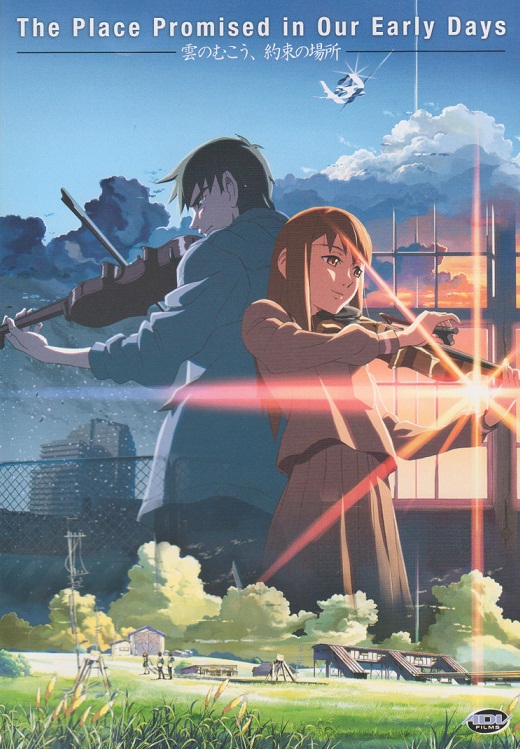 Continuing our weekend look at Makoto Shinkai’s films, I’d like to direct you to his second feature film from 2004, The Place Promised in Our Early Days (in Japanese, Kumo no Muko, Yakusoku no Basho, literally Beyond the Clouds, The Promised Place). I scribbled out three pages of nonsensical notes about the plot that I’m going to try and condense here without going too much into the story. The Place Promised has a much broader view that Shinkai’s other two films. The focus goes beyond just the main couple, or the main characters, and expands beyond their inner world. Personally I prefer the simplicity and intimacy of the other two films, but this one has a great deal of beauty as well. One of the things I love most about Shinkai is his ability to truly capture each moment. There’s not a frame in his films that shouldn’t be there. There’s never too much or too little; there’s just enough to convey the story and feelings that he wants to present. Every moment and every detail is created with great care.
Continuing our weekend look at Makoto Shinkai’s films, I’d like to direct you to his second feature film from 2004, The Place Promised in Our Early Days (in Japanese, Kumo no Muko, Yakusoku no Basho, literally Beyond the Clouds, The Promised Place). I scribbled out three pages of nonsensical notes about the plot that I’m going to try and condense here without going too much into the story. The Place Promised has a much broader view that Shinkai’s other two films. The focus goes beyond just the main couple, or the main characters, and expands beyond their inner world. Personally I prefer the simplicity and intimacy of the other two films, but this one has a great deal of beauty as well. One of the things I love most about Shinkai is his ability to truly capture each moment. There’s not a frame in his films that shouldn’t be there. There’s never too much or too little; there’s just enough to convey the story and feelings that he wants to present. Every moment and every detail is created with great care.
Unlike Voices of a Distant Star, The Place Promised is not set in the future, but rather an alternate reality closer to the present day (the late ’90s). A reality where north and south Japan have split apart into the Union and the Alliance (which has an American military presence). Middle school students Hiroki Fujisawa, Takuya Shirakawa, and Sayuri Sawatari live in the Alliance area. From many parts of the country, a large tower that reaches up into the clouds is visible. This tower, built by the Union, sits on the island of Ezo, which was once Hokkaido. Each of them feels somehow drawn to the tower in their own way. So much so that Hiroki and Takuya have been gathering parts together to build their own airplane so they can fly to the tower. One day they bring Sayuri, a girl they both admire, to see the plane, and the three make a promise to fly to the tower together, once the plane is finished. Together they dream about what lies beyond the clouds, until Sayuri suddenly disappears, and the boys stop working on the plane entirely. Three years pass, Sayuri seems to have vanished, and Hiroki and Takuya drift apart. Takuya attends a military school, where he does research on the Union’s tower and parallel universes, and Hiroki attends a high school in Tokyo, attempting to escape the visage of the tower. While Takuya works to discover the secrets of the tower, Hiroki fails to escape the memories of the past and a lingering connection he maintains with Sayuri through his dreams.
Sayuri, who disappeared without a word to her friends, lies asleep, locked in a dream. Her sleep has some sort of connection to the distant tower, which has the power to connect the world with parallel universes and overwrite it with them. She is the key to the world’s peace or destruction. In a world of war, where friends suddenly seem to be enemies and the very fabric of reality is threatened, can the three friends keep the promise they made in the naivety of their peaceful youth? Is the promise even worth keeping in the face of the world’s destruction?
There’s a lovely loneliness that permeates this film, as it does in Voices and She and Her Cat. Hiroki’s attempt to distance himself from his happy memories results only in a deep misery. He tries to move on and make new friends, but he can’t seem to find his way again. Takuya leaves his best friend behind and buries himself in his work in the laboratory studying the convergence of other universes. Sayuri, trapped in an endless dream, is perhaps the loneliest of all. Cut off from her friends, and the boy she loves, her mind is trapped in an unpopulated wasteland of broken towers that go on forever. The only thing binding them together (and indeed binding Sayuri to reality) is a youthful promise to fly to Hokkaido and see the mysterious tower. And somehow, none of them can fully move on while the promise remains unfulfilled.
Created by a full production team, as opposed to Shinkai alone (like Voices), The Place Promised has an excellent production value. Another beautiful, moving film, once again released domestically by ADV. There’s nothing particularly wrong with the English voice over, though I imagine having Shinkai on hand added something extra to the Japanese performances. This may not make sense, but I think the lyrical sounds of the Japanese language simply fit the film better than the English language. If you manage to find the DVD, there are some nice interviews with the main Japanese cast members, as well as an interview with Shinkai. There is also a manga adaptation of the story, but it is currently unlicensed in America. Head to Crunchyroll this weekend to watch the film online, or buy it from RightStuf for $22.49.
Don’t forget to stop by again tomorrow for a look at Shinkai’s third feature film, 5 Centimeters Per Second. If you missed yesterday’s look at Voices of a Distant Star: here you go.
Kris
kristin@comicattack.net
@girlg33k_Kris




Wow, this sounds really good. The animation is awesome and I have to tell you, the Japanese make the rest of the world look sad in this department. Well, except maybe Korea.